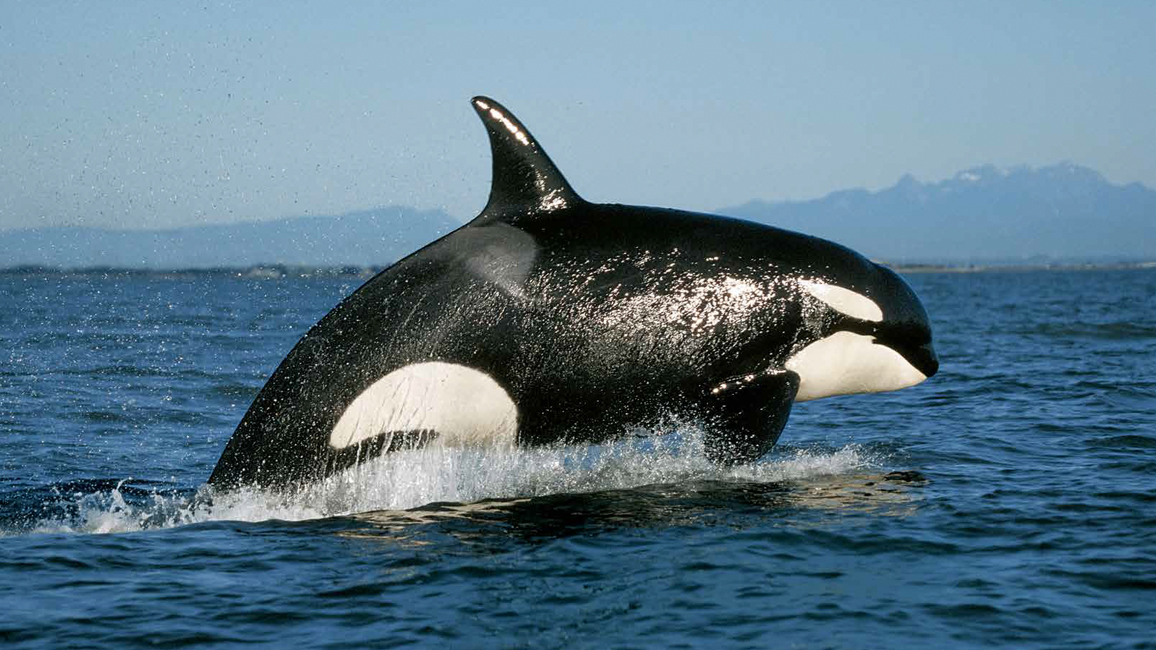
Ooh…Orcas!
By Kathy KrankingIt’s easy to recognize orcas—they’re dressed like giant Oreo cookies! But that’s not all that’s cool about them.
There’s more: They breathe from the tops of their heads. They can “see” with sound. And they’re actually giant dolphins!
Orcas’ size and strength are two other amazing things about these animals. Check out the one above. It looks like a black-and-white torpedo bursting from the water. A large male orca is almost as long as a school bus, and it weighs more than 10 bottlenose dolphins do!
Orcas are powerful swimmers, too. They can reach speeds of more than 35 miles per hour in short bursts—and that’s super fast for moving through water!
BLENDING IN
Orcas are the largest members of the dolphin family. They live in every ocean of the world, though most of them are found in colder waters along coasts.
Those famous black-and-white markings are more than just pretty: They help with camouflage. When seen from above, the orca’s black back blends in with the dark water. This makes it hard for animals looking at the water from an ice floe or beach to spot an orca. From below, an orca’s white belly blends with the light coming from above, making it harder for prey animals to see an orca swimming above them.
HOLE IN THE HEAD
Like other dolphins, an orca breathes through a blowhole on the top of its head. When the orca surfaces, it blows air out of the hole to exhale. Then it takes in a big breath before diving under again. To keep water from getting into the blowhole, a special muscle closes it up tight.
FAMILY TIES
Orcas travel in family groups called pods. A pod can have as few as five members or as many as forty. Sometimes pods combine to make groups of more than a hundred orcas.
Pods are usually made up of related mother orcas and their male and female young. Orca family bonds are very strong, and members may stay together for life.
Orcas belong to different groups, called ecotypes (EE-kohtipes). Scientists have discovered that each orca ecotype has its own behaviors that are different from those of other ecotypes. For example, some ecotypes eat only fish, while others eat only marine mammals. And some are very playful, while others are calmer.
ORCA CHAT
If you could dive into the water and swim along with a group of orcas, you’d be amazed at the noise you’d hear all around you. That’s because orcas “talk” to each other using different sounds.
The three main sounds orcas make are clicks, whistles, and pulsing calls, but they also make popping sounds and jaw claps. They’ll even slap their fins or tails against the surface of the water to make loud noises. Some of the sounds can be heard for miles! Scientists are studying orca talk to try to figure out what it all means.
ON THE HUNT
Orcas are also called “killer whales” because they’re such fierce predators. Whether they hunt separately or in a group, they have some clever tricks for catching prey. For example, orcas may swim toward an ice floe with a seal on it to make a big wave that knocks the seal off. Or an orca may come right out of the water onto a beach or ice floe to grab prey.
A group of orcas will herd a school of fish into a tight circle, and then whack at the group with their tails. This knocks out the fish so that the orcas can more easily gobble them up. An orca’s sharp, cone-shaped teeth are perfect for ripping and tearing food. Depending on their ecotype, orcas eat a variety of prey, including seals, fish, penguins, sea turtles, whales, and even other dolphins.
SEEING WITH SOUND
An orca has a neat way of zeroing in on prey: It uses echoes. This is called echolocation. (See diagram.) Here’s how it works: First an orca makes some clicking sounds by passing air between lip-like parts in its head, called phonic lips. The sounds pass through another part in the orca’s head, called the melon. The melon helps aim the sounds straight ahead (red lines). If the sounds hit something in front of the orca, they bounce back as echoes (blue lines). The sounds travel through a fat-filled part of the orca’s jaw to its ears, which are inside its head.
By listening to the sounds, the orca can tell the size and shape of the object, as well as how far away it is and which way it’s going. Orcas also use echolocation to find their way in murky water. So they really are “seeing” with sound!
ORCAS FOREVER!
Orcas are amazing creatures. From watching them in nature programs to enjoying them on whale-watching
tours, people can’t seem to get enough of orcas. Even people from long ago were fascinated by them, as you can see from this 300-year-old rock drawing of an orca (small photo).
And why not? Orcas have everything—brains, beauty, and strength, all wrapped up in a beautiful black-and-white package.
“Ooh…Orcas!” originally appeared in the March 2015 issue of Ranger Rick magazine.
(Click on each image above for a closer view of the story.)



















